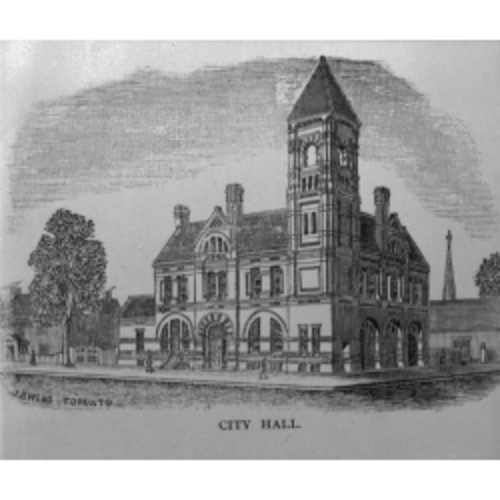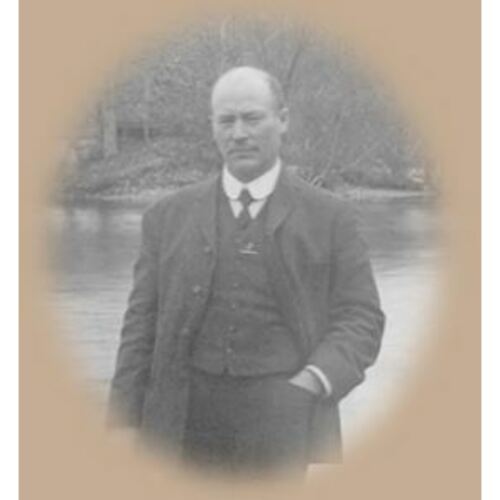
Source: Link
CHAPPELL, CHARLES BENJAMIN (baptized Benjamin Charles), carpenter and architect; b. 10 Oct. 1857 in Charlottetown, son of William Chappell and Mary Ann Turner; m. there 25 Sept. 1878 Louisa Jane Holman, and they had two daughters, who predeceased him, and two sons; d. there 1 Oct. 1931.
Charles Benjamin Chappell was the great-grandson of Benjamin Chappell*, who in 1774 had emigrated from England to St John’s (Prince Edward) Island, where he worked as a wheelwright, postmaster, and lay preacher; he is acknowledged to have been the father of Methodism in the colony. Charles’s father and grandfather had been carpenters in Charlottetown, and Charles learned the family trade.
It is not clear what formal education Chappell received, but his training as an architect was probably limited. In 1883 or early 1884 he formed a partnership with Lemuel John (also known as John Lemuel) Phillips. Phillips had been established as a contractor in Charlottetown from at least 1870, working with builder-architect Thomas Alley, and was himself listed as an architect in a city directory as early as 1880. In an 1889 advertisement Chappell and Phillips boasted that in the previous three years their firm had been responsible for “upwards of Forty Public and Private Buildings” in the Charlottetown area. In the 1891 census Chappell was identified as an architect.
After Prince Edward Island transitioned from colony to province in 1873 [see James Colledge Pope*], many government responsibilities were shifted from Charlottetown to Ottawa. Despite the diminished status of the provincial capital, its population increased during the three decades that followed, and there was considerable investment in both public infrastructure and private construction. The commercial area changed, the primarily wooden shops giving way to edifices of brick and stone. Much of this transformation was hastened by fires. In 1884 the business district on Richmond Street, facing Queen Square, was destroyed in a blaze. The disaster brought architect William Critchlow Harris* from Winnipeg in search of reconstruction work in his hometown. He led in this endeavour with a three-storey brick store. Chappell and Phillips also contributed: their Brown Block received praise, and by 1892 they had created all but two of the structures on what became known as Victoria Row. Chappell would later be responsible for a large number of commercial properties on adjacent streets.
The success of the Brown Block may have been what led to a significant commission for Chappell and Phillips: in 1885 they were approached about a new civic-administration building that would also accommodate the fire department. Harris submitted an unsolicited proposal, but it was rejected by city council and in 1887 the contract was officially awarded to Chappell and Phillips. Harris protested against the decision, claiming that the plan incorporated some of his ideas. The three-storey city hall, with its 80-foot tower to house the fire bell and allow for hose drying, was finished the following year. At about the same time, the firm received a contract for a new fish market, but when the general market in the main square burned down in 1902, the assignment for replacing it was won by Chappell’s rival, Harris.
Phillips left the partnership to pursue other interests in 1895, and Chappell maintained a solo practice for the next 20 years. Continuing to compete with Harris, he successfully secured contracts for the new Prince Edward Island Hospital and Prince of Wales College [see Alexander Anderson*]. He would be chosen again when tobacco magnate Sir William Christopher Macdonald* provided funds for a major addition to the college, completed in 1907. In the late 1890s he pursued projects in Nova Scotia and opened an office on Cape Breton Island in 1901, at a time of rapid expansion owing to the coal and iron-and-steel industries. He also provided designs for buildings in Ontario and New Brunswick. After 1903 most of Chappell’s work was on Prince Edward Island. He became a founding member of the Architectural Institute of Canada, which was established in 1908 with Alexander Francis Dunlop* as president, and he served on its council for the first two years.
In 1914 Chappell met John Marshall Hunter, who had come to Charlottetown from Montreal as principal architect for the rebuilding of the Roman Catholic cathedral, St Dunstan’s, which had been gutted by fire the previous year. The two established a personal and professional relationship, and in 1915 they formed Chappell and Hunter. Together they would renovate and design many residential, religious, and commercial sites in the province. After Chappell died in 1931, following an eight-month illness, Hunter would continue the practice under his own name.
More than any other architect, Chappell was responsible for the changing face of Charlottetown between the early 1880s and 1930. His influence extended beyond commercial properties: he undertook additions to St Dunstan’s College and provided plans for an opera house, the Queens County jail, and several railway stations and churches across the region. Hospital designs in his portfolio included those in New Glasgow, Glace Bay, and Antigonish, N.S., in Pembroke, Ont., and in his city. His greatest legacy, however, is as a domestic architect: his accounts record more than 150 residential commissions, many in developing areas of Charlottetown. His family was among the first to live in what would become the prestigious Brighton neighbourhood, in a home of his own design. Not only did Chappell produce an extraordinary number of buildings, but he also had a wide-ranging style. Although he lacked the unity evident in Harris’s work, throughout his 45-year career he displayed flexibility and skill at combining architectural features, which may have made his proposals more appealing to clients. In many of his structures he embraced the use of Romanesque Revival elements, such as large rounded arches, brick detailing, and asymmetrical façades. Examples include the city hall and the impressive Prince Street residence erected for merchant James Paton. Victoria Row’s Morris building exhibits an Italianate influence. He was also a proponent of the Queen Anne style, evident in the grand home envisioned for wine merchant James Eden on West Street, and he employed features of Colonial Revival design, then gaining popularity. His contribution represents a major part of the city’s architectural heritage. According to the Guardian (Charlottetown), “there is probably not a street in [the city] that doesn’t have at least one Chappell house on it” (2 Feb. 2016).
Many of Chappell’s edifices survive. More than 50 are included in the Canadian Register of Historic Places, and his name is associated with three national historic sites in the province: as the architect of Charlottetown’s city hall and of Kensington’s railway station, and as a key contributor to the construction of Dalvay-by-the-Sea, the extravagant summer home of American oil tycoon Alexander McDonald, which was purchased in 1937 by the federal government and is part of Prince Edward Island National Park of Canada.
PARO holds more than 1,000 sheets of architectural plans and drawings from the firms with which Charles Benjamin Chappell was associated. The fonds Chappell & Hunter, architects (Acc3607) includes works by Phillips & Chappell and Chappell & Hunter. Of particular note is series 6, which includes ledgers, accounts, and a list of all the projects in which Chappell was engaged. The Chappell family fonds (Acc5130) contains a number of records pertaining to the subject. The City of Charlottetown Council minute books (part of RG20) provide details about the design of the city hall and the later competition for the market building. An extensive, although incomplete, listing of Chappell’s work can be found in R. G. Hill, “Biographical dictionary of architects in Canada, 1800–1950”: www.dictionaryofarchitectsincanada.org (consulted 11 Dec. 2017). Chappell is the author of “The burial place of John Plaw,” Architectural Rev. (London), 45 (1919): 130–31.
PARO, Trinity United (First Methodist) Church (Charlottetown), Reg. of baptisms, 18 Aug. 1859. Charlottetown Guardian, 1893–1945. Daily Examiner (Charlottetown), 1880–1910. Guardian of the Gulf (Charlottetown), 1945–49. H. [T.] Holman, “From house carpenter to architect: Charles B. Chappell and the changing face of Charlottetown,” Island Magazine (Charlottetown), no.78 (fall/winter 2015): 2–12. P. E. Rider, Charlottetown: a history (Charlottetown, 2009). I. L. Rogers, Charlottetown: the life in its buildings (Charlottetown, 1983).
Cite This Article
Harry Tinson Holman, “CHAPPELL, CHARLES BENJAMIN (baptized Benjamin Charles),” in Dictionary of Canadian Biography, vol. 16, University of Toronto/Université Laval, 2003–, accessed December 22, 2025, https://www.biographi.ca/en/bio/chappell_charles_benjamin_16E.html.
The citation above shows the format for footnotes and endnotes according to the Chicago manual of style (16th edition). Information to be used in other citation formats:
| Permalink: | https://www.biographi.ca/en/bio/chappell_charles_benjamin_16E.html |
| Author of Article: | Harry Tinson Holman |
| Title of Article: | CHAPPELL, CHARLES BENJAMIN (baptized Benjamin Charles) |
| Publication Name: | Dictionary of Canadian Biography, vol. 16 |
| Publisher: | University of Toronto/Université Laval |
| Year of publication: | 2022 |
| Year of revision: | 2022 |
| Access Date: | December 22, 2025 |




